The Beast Within: Wildlife Artist John Banovich
A DM Interview
“Now more than ever, we need to expand the message about the vital importance of the world’s natural places and utilize the forceful role that artists can leverage in the efforts to conserve them. Through my artwork, I hope to move, reveal and inspire people to seek a deeper understanding of the world around us and bring together groups of individuals to unite on a common ground. Our natural world is severely threatened and with this increased pressure, a new paradigm must emerge...artists, conservationists, sportsmen and environmentalists must come together in areas of overlapping interests."
Tell us what you are working on this winter.
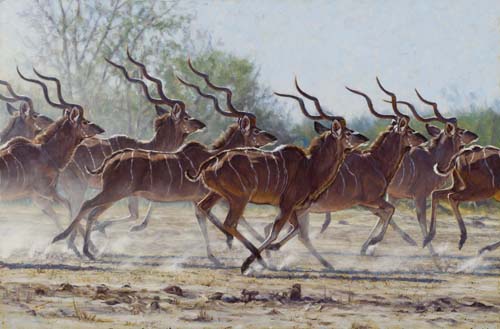
I am currently working on several large commissions. I always appreciate a client who reaches past the ordinary into extraordinary. I have the unique privilege to make two artworks for a client who is building a house that is made almost entirely out of glass. The walls, the ceiling, the doors, everything is glass with the exception of two opposing stone fireplaces which will accommodate the two paintings. The paintings will be the focal point of the estate and celebrate the beauty of flight — one painting will feature a covey of flushing quail and the other shows a flock of flushing ducks taking off from the water.
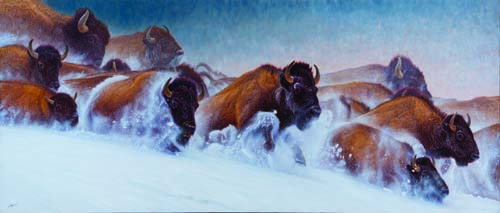
I am also working on new paintings to be included in my upcoming museum exhibition, “John Banovich: The African Lion” at the Nevada Museum of Art in Reno, Nevada. The body of work will span nearly 25 years and focus on the African Lion, exploring questions about mankind’s deep fear, love, and admiration for these great creatures. Opening June 10 through August 27, 2017.
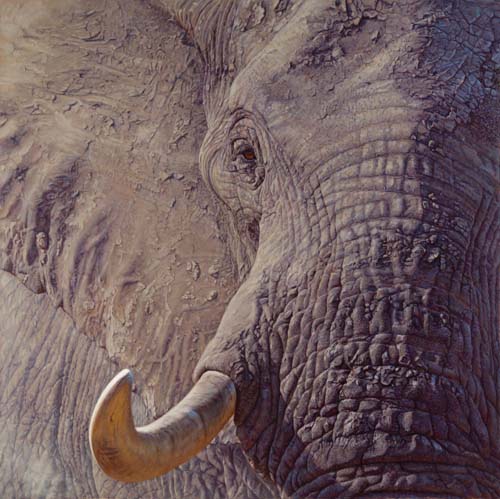
Recently I returned from a trip to Africa with Ernest Sabine, the designer of some of the most stylish bags and menswear fashion in America, “Ernest Alexander.” Coupling rich leathers and precise and practical design, each piece is thoughtfully and beautifully created. During our travels we discussed a collaboration to create a Banovich line of luxury travel bags and clothing inspired by my artwork and African adventures. In the precious few moments away from the easel I am thrilled to be bringing this concept to fruition with the goal to have the first bag produced and available early next year.
How and when did your artistic journey begin?
My journey began in many ways at age seven when I completed my first oil painting titled, Meeting of the Gang, featuring Rudyard Kipling’s The Jungle Book characters. I have always been enchanted and intrigued by exotic animals.
What are your earliest memories of being drawn to painting as a lifetime endeavor?
My eldest sister, Teri, was instrumental in my introduction to painting. Despite my young age, she took it upon herself to teach me how to paint with oil paints, which is a sophisticated medium for an artist of any age. I wanted to make my work come to life, as if it was poised between heartbeats. Later in my artistic journey I learned about the art of the brush and paint. I adopted a “less is more,” approach and honed my ability to paint the essence of things rather than a literal interpretation. After 44 years of painting animals, I am still in pursuit of their essence.
How did you come about wildlife as your life-long subject matter?
Painting animals allows me to fall into a rhythmic dance. They are living, breathing, and awe-inspiring creatures. Painting a wild beast makes me feel as if I am paying homage to them. It is starkly apparent that nearly every large wild species on earth is experiencing a decline in population. Wildlife one day will only be experienced in captivity, on film and on canvas. I feel a great responsibility to document how humans feel about our time on earth, living beside “Big Things with Big Teeth.”
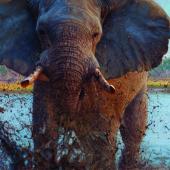
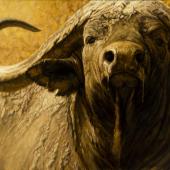
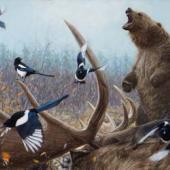
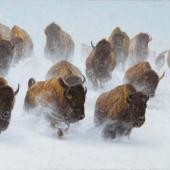
Montana is often described as the “American Serengeti,” yet your artistic passion most often takes you to Africa and its wildlife. What is the interplay between the two?

I grew up in Butte and have spent nearly half my life roaming the mountains and valleys of the Northwest. The other half of my life has been spent roaming the Savannahs and Bushveld of Sub-Saharan Africa. There are many similarities between Montana and Africa. Both have tremendous wildlife with large numbers of herbivores and carnivores roaming the landscape. For me the most notable aspect of both places is their ability to capture your soul.
What was your most difficult work to complete and why?
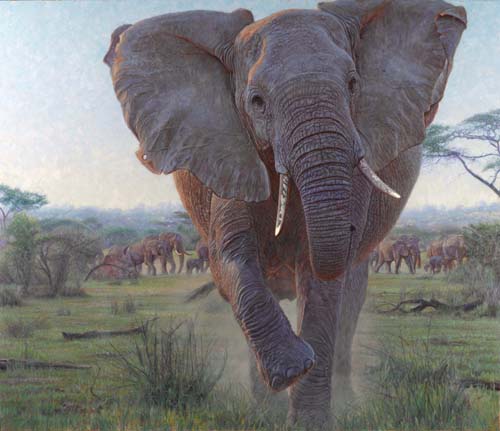
There are two that stand out. One is a commission for the Yellowstone Club’s Warren Miller Lodge. It depicts a herd of Bison plowing through the deep snow called Cold Air-Deep Powder. The research for this was on Ted Turner’s Flying D Ranch; it was very challenging to ‘inspire” these shaggy beasts to run through the snow when there were no wolves chasing them.
The other challenging work was a commission called Bad Day for part-time Montana resident and founder of the Montana Meth Project and Siebel Systems, Mr. Tom Siebel. Tom commissioned one of the most thrilling and powerful works I have ever created, memorializing the elephant attack he barely survived. In August of 2009, Siebel was on safari in Tanzania with his family, when he was attacked by a cow elephant. In the wrong place at the wrong time, he sustained extensive injuries. The background shows the African safari with a grazing herd of elephants; however, the main focus is that of the hulking female elephant that is thundering toward the viewer with only a few feet to spare before contact. The piece transports the viewer to the last terrifying moments Siebel faced before the elephant struck. This painting will always be one of the most personal works I have ever created. It took extensive research to accurately portray the profound event that changed Tom’s life forever and the painting will tell the story for generations to come.
Painting seems to many to be so sublime, yet you have said that “the process of painting does not enrapture me — that blissful feeling ends once the concept is set in my mind. Then the process becomes arduous.” Does the act of painting seem more a work or a joy?
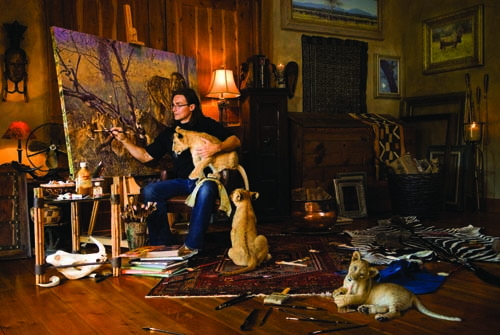
Creating the work in your mind is the pinnacle of the process.
I can see the image, as I stare at the blank surface, its details, edges, values, and hues flawless and set upon a perfect composition. Once I have it sketched out on the canvas ready to go, discipline comes in. This is especially true for a large canvas as it may take months to complete and physically tests my endurance, even for a former Mr. Montana bodybuilder!
Who is John Banovich is in just seven words?
A tormented artist searching for the soul of his subjects.
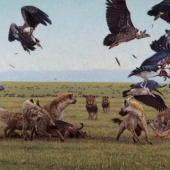
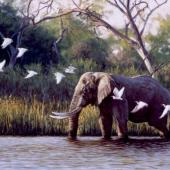
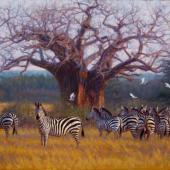
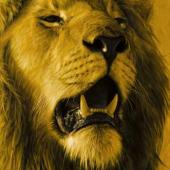
* * * *
ABOUT JOHN BANOVICH'S WILDSCAPES FOUNDATION
The mission of Wildscapes is to foster cooperative efforts to conserve the earth’s wildlife and wild places benefitting the animals and people that live there. We accomplish this in three ways: 1) Supporting important science research and education. 2) Protecting large conservation landscapes. 3) Finding ways to benefit community development. I founded BWF because I saw there was a chasm between the sportsman conservationists and the conservationist environmentalists. Prior to the 1960’s, these individuals and groups worked, for the most part, in tandem on environmental and conservation issues. Today you see the groups working independently because of differences in fundamental beliefs that either wildlife is a resource to be used, or wildlife should have individual rights and be protected at all costs…even at the cost of the species as a whole. The reality is that wildlife must be utilized, both consumptively and non-consumptively (depending on the landscape), and local people must benefit from its presence. If not, the wildlife will disappear. I call this the second inconvenient truth. Today wildlife must pay in order to stay. In an ever-exploding human population of over seven billion and growing, wildlife must bring value to communities; it must compete economically with other land use choices. In the future these Wildscapes will become more valuable than anything we have, more valuable than anything that can grow on them, anything that can be built on them, or anything that can be extracted from underneath. If the animals continue to be poached, removed and exploited for whatever reason, they will go extinct and we humans will lose a part of ourselves.
ABOUT THE ARTIST
John Banovich is a world-renowned artist, deeply inspired by wildlife. His over 850 artworks have won awards and been exhibited in museums and noteworthy collections all over the globe. Here he paints in his Montana studio. Visitwww.johnbanovich.com to learn more and view his digital art gallary.
UPCOMING WINTER SHOWS
January 7 – 10: Dallas Safari Club Convention, Dallas, TX
January 15 – 17: Houston Safari Club Convention, Houston, TX
February 3 – 6: Safari Club International Convention, Las Vegas, NV
February 12 – 14: Southeast Wildlife Exposition, Charleston, SC
VIDEO: Cold Air Deep Powder by John Banovich
Wildlife painter John Banovich spent a great deal of time this large canvas to be shown at the YellowStone Club In December 2012. This video shows the stages and thoughts of John's background in his master piece as well as a sneak added to the end of the video from the actual unveiling of the painting itself.
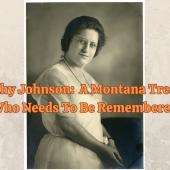


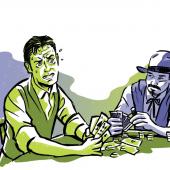
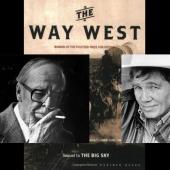







Leave a Comment Here